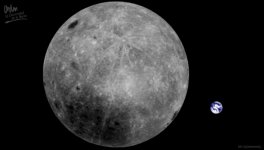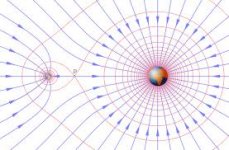If I'm not mistaken, the current theory of the differing looks...over the millions of years, the actual heavier elements within the globe structure itself, migrated to the surface & those heavier elements started "surfacing" on our observable side.
=========================================Rick....
... or our shield has taken som beating during the years...
//
They say the Greeks are returning to their ancient system of barter. In Crete, I am reliably told, it has never gone away!
But, we digress. What's your theory on the different appearances of the near and far sides of the Moon?
long ago we should have been able to go there on holiday, and see for our selfs what the difference is. !!!
Okay, I'll explain it quickly. During the formation of our Solar System, while the Earth was still semi/molten, there was a collision with an asteroid/meteor or comet which caused what is now our Moon to separate and be thrown into it's current orbit where it cooled along with the Earth. And they are both living happily ever after as that big smile out there will testify to.What's your theory?
And that's that.😎
It was a reference to forum rules. Meant with the lighter side of the definition. I think there's a pun in there somewhere🙂"a person or thing accursed or consigned to damnation or destruction." nice
thanks for that
Thanks for attempting to put the accent back on space!If I'm not mistaken, the current theory of the differing looks...over the millions of years, the actual heavier elements within the globe structure itself, migrated to the surface & those heavier elements started "surfacing" on our observable side.
There are many suggestions as to the reasons for the difference in appearance between the far side of the Moon and the near side. The latest theory is that heat from the early, molten Earth delayed the condensing out of rocks on the near side of the Moon. Rock formation was favoured on the cooler, far side which resulted in the crust on the far side of the Moon becoming thicker than on the near side. In consequence, the far side could withstand meteoritic impact, as attested to by the proliferation of craters on the far side.
On the other hand, the thinner near side was easily punctured by meteoritic bombardment, allowing lava to flow out to form the dark maria areas which differentiate the near side from the far side.
But is there enough evidence of cross fire on the Earth that would support your hypothesis? Have they been mapped/documented?
It's not my hypothesis. I'm not brainy enough to have hypotheses. I rely on other people to have them!
Now, what is 'cross fire' and what are the 'they' to which you refer? 😕
Now, what is 'cross fire' and what are the 'they' to which you refer? 😕
I was asking for a theory as to why the far side of the Moon looks different from the near side.Okay, I'll explain it quickly. During the formation of our Solar System, while the Earth was still semi/molten, there was a collision with an asteroid/meteor or comet which caused what is now our Moon to separate and be thrown into it's current orbit where it cooled along with the Earth. And they are both living happily ever after as that big smile out there will testify to.
Instead, you have given me a theory about the formation of the Moon - quite a different subject!
I see I'm the mug after all🙂It's not my hypothesis. I'm not brainy enough to have hypotheses. I rely on other people to have them!
Now, what is 'cross fire' and what are the 'they' to which you refer? 😕
Yes I see that. So what do you think? Yours is a bit suspect regarding the the differences. Hence my query.😛I was asking for a theory as to why the far side of the Moon looks different from the near side.
Instead, you have given me a theory about the formation of the Moon - quite a different subject!
It's not mine and, as I said, there are many alternative theories. Perhaps you could quote one which is less 'suspect' in your eyes?Yours is a bit suspect regarding the the differences.
Of course not. The one you cite is as valid as any within reason. I'm just having a conversation here. I defer to you. My question is borne of a pure motive🙂 So what about the crossfire? If the Moon has been bombarded as you've described, does the coincidental bombardment of the Earth attest to the proposed outcome/result?
I don't know what you mean by 'proposed outcome/result'. I hope this reply is relevant to your question.
The Earth developed an atmosphere very early on, which protected it from space debris, apart from the bigger (asteroid sized) chunks.
The Moon, with only 1/6th of the Earth's gravity, failed to hold onto its atmosphere, exposing it to violent bombardment by debris of all sizes.
The Earth developed an atmosphere very early on, which protected it from space debris, apart from the bigger (asteroid sized) chunks.
The Moon, with only 1/6th of the Earth's gravity, failed to hold onto its atmosphere, exposing it to violent bombardment by debris of all sizes.
I was asking for a theory as to why the far side of the Moon looks different from the near side.
I suppose if the moon presents only one face to earth at all times, I would expect the (to us) dark side of the moon to be more damaged by meteorite impacts, due to the combined pull of the earth's and the Moon's gravity wells. Additionally, I would expect the Earth itself to act as a shield from meteorite impacts on the bright ( to us) side of the Moon.
I have no way to guess the percentage of higher damage to the dark side of the Moon, since I have no way of knowing when its rotation slowed so much it always shows the same hemisphere to us.
Probably after the heaviest interplanetary bombardments took place, with leftover materials from the formation of our solar system.
Too bad Zecharia Sitchen isn't around to ask, anymore. 😁
Looking at the attached photo, it does not appear that the Earth would be much of a shield.I would expect the Earth itself to act as a shield from meteorite impacts on the bright ( to us) side of the Moon.
In fact, the Earth obscures only about one ten-thousandths of the sky as seen from the Moon. This makes the Earth negligible as a shield for the Moon.
Attachments
Looking at the attached photo, it does not appear that the Earth would be much of a shield.
In fact, the Earth obscures only about one ten-thousandths of the sky as seen from the Moon. This makes the Earth negligible as a shield for the Moon.
Are you factoring in its gravity well, acting as a vacuum cleaner (hah!) ?
Also there's no erosion on the Moon from wind and rain, so I don't know how much of the impact craters are from a time before its rotation slowed, so that only one hemisphere faces us.
The combined gravitational field of the Earth and the Moon is shown in the attached diagram.I suppose if the moon presents only one face to earth at all times, I would expect the (to us) dark side of the moon to be more damaged by meteorite impacts, due to the combined pull of the earth's and the Moon's gravity wells.
Looking at the lines of force, it would appear that approaching debris would be pulled either towards the far side of the Moon or directly towards the Earth.
However, this hypothesis may be too simplistic as the space debris would have been travelling in all directions with velocities high enough to defy the force of gravity (which, of course is effectively zero at the null point, P).
I haven't found any archived information which confirms or denies the hypothesis. Any further contributions would be welcome! 🙂
Attachments
- Status
- Not open for further replies.
- Home
- Member Areas
- The Lounge
- What is the Universe expanding into..

